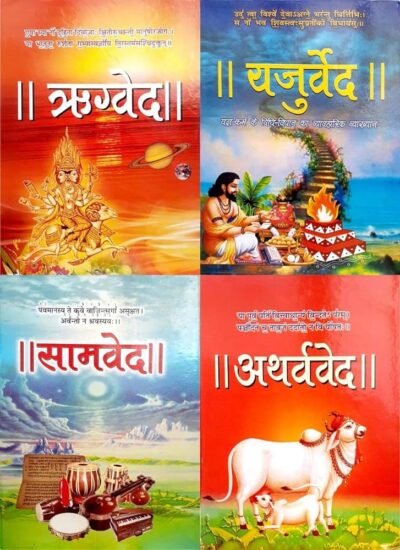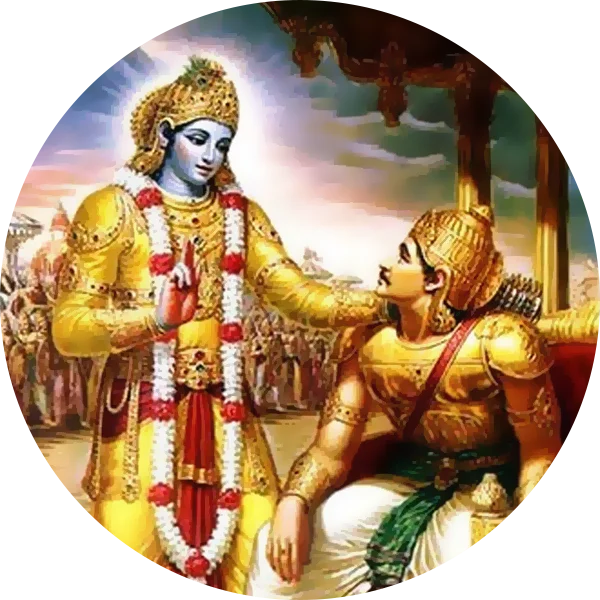The Vedas are a collection of ancient sacred texts that form the foundation of Hinduism. They are composed in Vedic Sanskrit and are among the oldest religious texts in the world. The Vedas are revered as “śruti” (that which is heard) and are considered the direct revelation of the divine to ancient sages or rishis. There are four main Vedas, each with its own distinct content and focus.

The Four Vedas
- Rigveda:
- Content: The Rigveda is the oldest and most important of the four Vedas. It consists of 1,028 hymns (sūktas) divided into 10 books (mandalas). The hymns are dedicated to various deities such as Agni (fire god), Indra (king of gods), and Soma (a sacred ritual drink).
- Focus: The primary focus is on hymns of praise and invocations used in rituals and sacrifices.
- Samaveda:
- Content: The Samaveda is a collection of melodies (sāman) and chants. It contains around 1,549 verses, most of which are derived from the Rigveda but are set to music.
- Focus: The focus is on the musical and melodic aspects of chanting during rituals. It is considered the Veda of melodies and chants.
- Yajurveda:
- Content: The Yajurveda is divided into two main parts: the “White” (Shukla) Yajurveda and the “Black” (Krishna) Yajurveda. It consists of prose mantras and verses that provide instructions for performing sacrificial rituals.
- Focus: It emphasizes the procedures and liturgies for various sacrifices (yajnas) and rituals.
- Atharvaveda:
- Content: The Atharvaveda is a collection of hymns, spells, and incantations. It includes a wide range of topics, including medicine, magic, and daily life.
- Focus: It deals with practical aspects of daily life, including healing, protection, and rituals for prosperity and well-being.
Structure of the Vedas
Each Veda consists of four parts:
- Samhitas: The core texts containing hymns and mantras.
- Brahmanas: Prose texts that explain the Samhitas and provide instructions for rituals.
- Aranyakas: “Forest books” that serve as a bridge between the ritualistic Brahmanas and the philosophical Upanishads.
- Upanishads: Philosophical texts that explore metaphysical concepts and the nature of reality. They are considered the essence of Vedic thought and the foundation of Vedanta philosophy.
Importance and Influence
- Religious Significance: The Vedas are the primary scriptures of Hinduism and are considered the ultimate authority in Vedic rituals, ceremonies, and spiritual knowledge.
- Cultural Influence: The Vedas have had a profound impact on Indian culture, philosophy, and society. They have influenced various aspects of Indian life, including art, music, and literature.
- Philosophical Contributions: The Upanishads, in particular, have contributed significantly to Indian philosophical thought, introducing concepts such as Brahman (ultimate reality), Atman (soul), and moksha (liberation).
Preservation and Transmission
The Vedas have been preserved through an oral tradition known as “shruti,” where they were memorized and passed down through generations by Brahmin priests. This meticulous oral transmission has helped maintain the accuracy and purity of the texts over millennia.
Conclusion
The Vedas are not only sacred texts but also a treasure trove of ancient knowledge encompassing religion, philosophy, science, and art. They continue to be revered and studied, offering insights into the spiritual and intellectual heritage of ancient India.
Leave your comment
Related posts
The holy Gangotri water — often called "Gangajal" — holds immense spiritual, cultural, and even scientific significance in Hindu Dharma. Here's a comprehensive breakdown of what makes Gangotri water sacred [...]
The Shreemad Bhagavad Gita, often simply called the Gita, is a 700-verse Sanskrit scripture that is part of the Indian epic Mahabharata (Book 6 – Bhishma Parva). It is presented [...]
Bhaja Govindam, also called Charpat Panjarika Stotram, is a devotional and philosophical hymn composed by Adi Shankaracharya. It emphasizes the impermanence of worldly pleasures and encourages devotion to Govinda (Krishna) [...]




